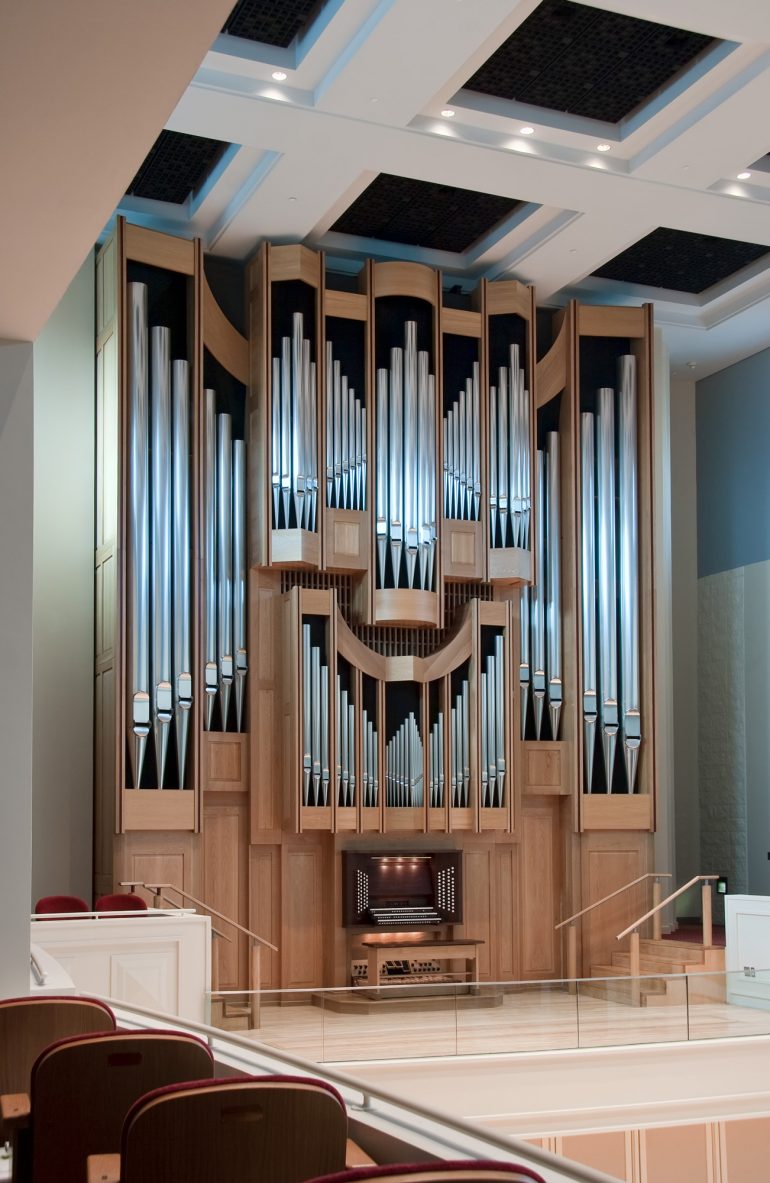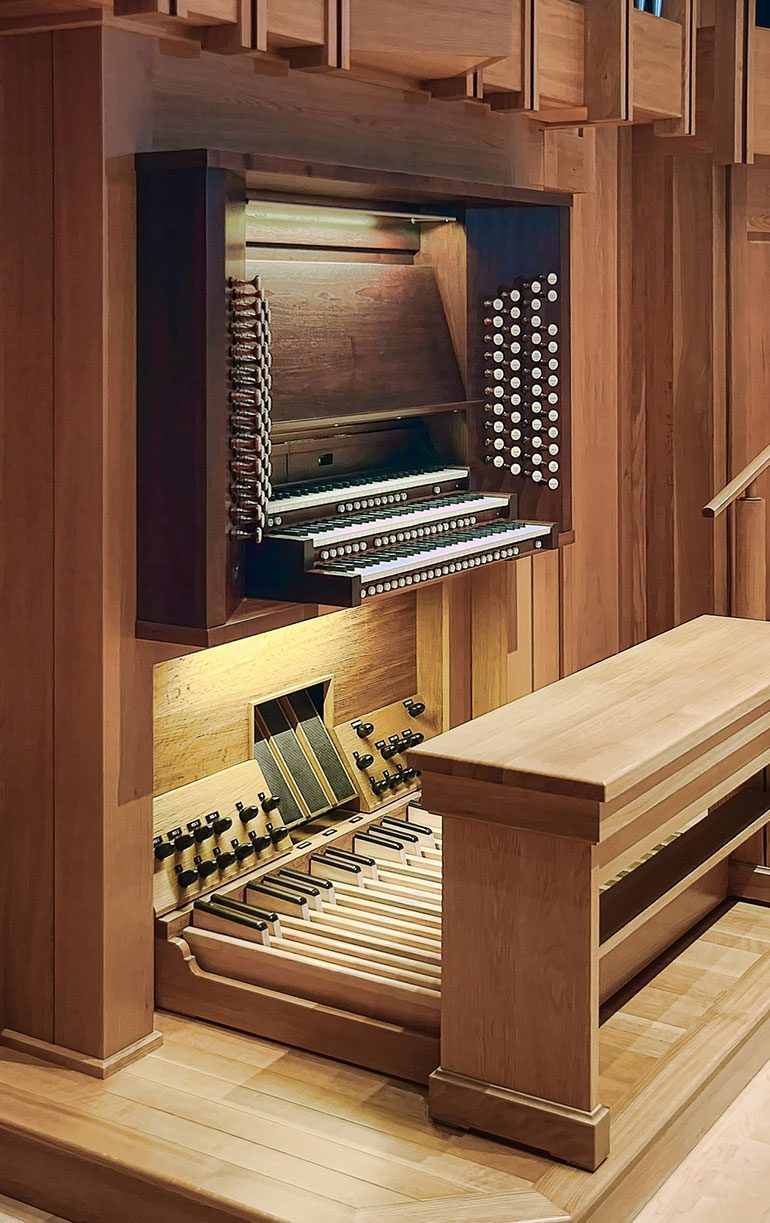
- phone: 978.283.1909
- email: cbfisk@cbfisk.com
Opus 135
Jacobs School of Music, Indiana University
Bloomington, IN
Stops: 70
Ranks: 68
Independent Voices: 57
Pipes: 3945
Created: 2010
Building an organ in Auer Hall presented a unique challenge to our shop. We have many organs in academic settings, fully a third of all Fisk instruments are used for teaching, but we had never been commissioned to complete an organ begun by another builder. Our first question was whether the existing work could be incorporated in an organ consistent with the requirements of the Jacobs School of Music and our vision for this important recital instrument. The answer lay in a thorough survey of existing pipework, components and structure and considerable discussion.
With then Department Chair Chris Young we explored the faculty’s desire for an instrument with a decidedly 19th Century French character that would also incorporate the level of eclecticism necessary for performance of a wide range of music with authenticity and authority. Additionally, we were asked to make as little change to the existing case as possible.
Our analysis revealed that by moving the organ further up and back in its gallery, useful space could be gained for master classes and instrumentalists. Such a change required a complete reorganization of the divisions within the case, new structural support and accommodations to Auer Hall itself. These changes created the opportunity for significant improvements in the room’s acoustic properties. With the advice of acoustician Dana Kirkegaard, walls were made more massive, diffusers were added in the ceiling coffers, and the panels surrounding the stage were replaced, all resulting in a warmer, clearer, more bass-friendly sound; all to the benefit of the various voices and instruments that can be heard throughout the year in this busy concert hall.
The final specification includes less than half of the former organ’s pipework. All of the key action, stop action, wind chests, expression boxes and ducting are new.
Great, Manual I
Montre 16′
Montre 8′
Gambe 8′
Spire Flute 8′
Flûte harmonique 8′
Prestant 4′
Chimney Flute 4′
Quinte 2 2/3′
Doublette 2′
Tierce 1 3/5′
Plein jeu harmonique II-VI
Plein jeu VI
Trommet 16′
Trommet 8′
Trompette 8′
Clarion 4’
Positive, Man II, enclosed
Quintaton 16’
Principal 8′
Viole d’amore 8’
Unda maris 8′
Gedackt 8′
Flute Celeste 8’ II
Octave 4′
Violina 4′
Hohlflöte 4’
Nasard 2 2/3′
Doublette 2′
Quarte de Nasard 2’
Tierce 1 3/5′
Larigot 1 1/3’
Mixture IV
Clarinet 16′
Cornopean 8′
Tuba mirabilis 8′
Swell, Man III, enclosed
Bourdon 16′
Diapason 8’
Viole de gambe 8′
Voix céleste 8′
Flûte traversière 8′
Bourdon 8′
Dulciane 4’
Flûte octaviante 4′
Nasard 2 2/3’
Octavin 2′
Tierce 1 3/5′
Plein jeu IV
Basson 16′
Trompette 8′
Hautbois 8′
Voix humaine 8′
Clairon 4′
Pedal, 32 notes
Principal 32′ ext. Montre
Contrebasse 16′
Montre 16′ from Gt.
Soubasse 16′
Bourdon 16′ from Sw.
Quinte 10 2/3′ ext. *
Octave 8′
Flûte 8′ ext. Contrebasse
Violoncelle 8’ from Gt.
Spire Flute 8′ from Gt.
Bourdon 8′ ext. Soubasse
Octave 4′
Contre Posaune 32′
Bombarde 16’
Posaune 16′ ext.
32’
Trommet 8′ Alt. Gt.
Trompette 8′ Alt. Gt.
Clairon 4’ Alt. Gt.
Couplers:
Positive to Great
Swell to Great
Swell to Positive
Octaves graves
Great to Pedal
Positive to Pedal
Swell to Pedal
Swell to Pedal 4′
Accessories:
Great and Positive
Tremulant
Swell Tremulant
Flexible Wind
Cymbelstern
Nightingale
Crescendo Pedal
Kowalyshyn Servopneumatic Lever: provides a pneumatic assist (similar to a Barker Machine, but more refined) to the Great key action. It also allows the addition of the “Octaves graves” coupler to the organ. This coupler couples the servopneumatic lever to itself one octave lower. Therefore it couples the Great to itself at sub-octaves and any division coupled to the Great also appears on the Great at sub-octaves.
Manuals: CC – c4, naturals of bone, ebony sharps
Pedalboard: CC – g1, parallel, concave following 19 th century French models
Mechanical key action, electric solenoid stop action with Solid State Organ Systems combination action
* The Quinte 10 2/3’ is an extension of the Soubasse 16’ or the Contrebasse 16’ if it is drawn.
Alternating stops have two stop knobs, one in the Great and one in the Pedal. The stop may be used in one division or the other, but not simultaneously unless the Great to Pedal coupler is drawn.


